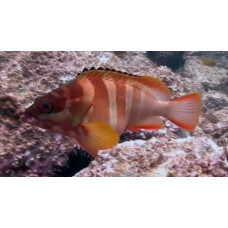Latin name
Epinephelus fasciatus
Other name
Redbanded grouper, blacktipped cod, black-tipped rockcod, footballer cod, red-barred cod, red-barred rockcod, scarlet rock-cod or weathered rock-cod.
Identification
The body of the blacktip grouper is somewhat elongated, covered with ctenoid scales with additional scales. Occiput and upper part of head covered with very small additional scales. Body length is less than head length, ranging from 2.8 to 3.3 times standard body length (for individuals 10 to 26 cm long). The length of the large head is 2.3-2.6 times less than the standard body length. The upper profile of the head is convex. The interorbital space is flat. The forehead is rounded, the posterior margin is notched. The upper edge of the gill cover is straight. The gill cover has three spines. The upper jaw reaches or passes behind the vertical of the posterior eye margin. The medial part of the lower jaw bears 2-4 lateral rows of small teeth. The nostrils are of equal size. There are 6-8 gill stamens on the upper part of the gill arch and 15-17 on the lower part. Lateral line with 49-75 scales. Pyloric appendages 10-16.
Features of fish fins
Long dorsal fin with 11 hard barb rays and 15-17 soft rays; rays three to eleven are almost equal in length and shorter than the longest soft ray. Anal fin with 3 hard and 8 soft rays. Pectoral fins with 18-20 soft rays, slightly longer than pelvic fins. Caudal fin rounded: In Central Pacific individuals, the caudal fin is often truncated.
Fish colouring
The basic colouration of the body varies from pale greenish-grey to pale reddish-yellow to scarlet. There are 5-6 dark stripes along the sides of the body, the last on the tail peduncle. Scales on the body (except on the belly) with a light centre and dark edges, forming a faint checkered pattern. There are usually pale spots and irregularly shaped dots scattered over the body (in the midsection the spots gradually decrease in size from the base of the pectoral fins to the tail peduncle). A dark brown stripe runs along the base of the dorsal fin. The upper part of the head and neck, as well as the upper jaw, are dark red or reddish brown, or have stripes and blotches of a similar colour. In most individuals, a dark band runs from the eye to the inter-mandibular bone. The orbital rim of the eye is black and often has a pale blue border. Fins are reddish-orange, pale yellowish-green or greenish-brown. The outer triangular part of the interorbital membrane of the dorsal fin is black (dark red in fish from Western Australia and some deep-water individuals). Behind the tip of each dorsal fin ray is a pale yellow or white spot. The soft part of the dorsal, anal and caudal fins have pale yellow, white or pale blue edges. The posterior part of the pectoral fins may be yellowish.
Distribution
One of the most abundant grouper species in the Indo-Pacific region and one of the most widely distributed grouper species in the world. It is distributed from the Red Sea along the east coast of Africa to the latitude of Port Alfred (33°36' S) and western Australia. In the Pacific, the range extends from Japan (33°N) and Korea to southern Queensland and Lord Howe Island. Occurs off all islands in the tropical and subtropical Indian Ocean and western Pacific to the Pitcairn Islands. Not found in the Persian Gulf or off Hawaii.
Habitat
Benthic marine fishes. They live near coral and rocky reefs at depths of up to 160m, but are often found in shallow bays and lagoons near the coast at depths of up to 15m.
Size
Maximum length 40 cm, usually up to 22 cm; body mass up to 2 kg.
Behavior
They feed both during the day and at night.
Food and feeding habits
Its diet consists of fish, crabs, shrimps, rotifers, ophiura and octopus. In Madagascar it feeds on crabs, fish and shrimps. In Kenyan waters it feeds on crabs, estuarine fish, fish, ophiura and octopus. In the Red Sea it feeds mainly on fish and some crustaceans (mainly crabs). Cooperative hunting with moray eels and octopuses has been observed.
Reproduction
This species exhibits a combination of simultaneous and sequential hermaphroditism. Smaller individuals within a social group are simultaneously hermaphroditic, while the largest often lose their female function and reproduce exclusively as males.
Fishing
They are fished in coastal areas throughout their range. They are caught using longlines, traps, harpoons and gill nets.
Relationship with a person
Reports of ciguatera poisoning.
| Classification | |
| Phylum | Chordata |
| Class | Actinopterygii |
| Squad | Perciformes |
| Family | Serranidae |
| Genus | Epinephelus |
| Species | E. fasciatus |
| Features | |
| Conservation status | Least Concern |
| Habitat | Pelagic |
| Life span, years | No information |
| Maximum body weight, kg | 2 |
| Maximum length, cm | 40 |
| Sailing speed, m/s | No information |
| Threat to people | Edible |
| Way of eating | Predator |
Blacktip grouper
Tags: blacktip grouper



